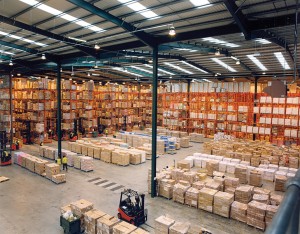 Inventory is expensive. Depending on your environment, inventory will cost you between 30% and 65% of its value. Toyota is known for (among other things) small inventories. Whereas Western companies often have weeks’ or even months’ worth of inventory, Toyota’s inventory is measured in hours.
Inventory is expensive. Depending on your environment, inventory will cost you between 30% and 65% of its value. Toyota is known for (among other things) small inventories. Whereas Western companies often have weeks’ or even months’ worth of inventory, Toyota’s inventory is measured in hours.
It is no surprise that inventory reduction is high on the list for many companies. In fact, the term “lean” by itself implies lower inventories. But why do we have inventory in the first place? And why is (too much) inventory considered evil in lean manufacturing? In this post I would like to tell you the reasons why we have inventory in the first place, and why too much is bad. In my next post I will explain what happens if you simply reduce inventory, and discuss in more detail better approaches on how to reduce inventory.
Why Do We Have Inventory?
 There are three reasons why we have inventory. For simplicity’s sake I include all parts that are needed for manufacturing in inventory, including raw materials, work in process, and finished goods. In order of priority, these three reasons for inventory usually are:
There are three reasons why we have inventory. For simplicity’s sake I include all parts that are needed for manufacturing in inventory, including raw materials, work in process, and finished goods. In order of priority, these three reasons for inventory usually are:
Decouple Fluctuations

The primary reason is to decouple fluctuations. Fluctuations are any unexpected changes in your value stream. This includes suppliers (delayed shipment, bad quality, …), your own value chain (machine breakdown, workers calling in sick, mix up in the schedule, capacity constraints, …), and your customers (order early, order more than expected, order less than expected, changing orders …). All of those mess up your plans. A buffer inventory will keep your customers happy and your workers busy, even if there are (smaller) fluctuations. If you need more than expected, you decrease your buffer stock; if you need less than expected, you increase your buffer stock.
Of course, inventory is only one way to decouple fluctuations. The others are capacity and time (see The Three Fundamental Ways to Decouple Fluctuations). However, ramping capacity up and down quickly is difficult, and there are usually upper and lower limits as well. As for time, if you can let the customer or your workers wait, this will be an option. However, often this is not possible. In sum, inventory usually is the workhorse to decouple short-term fluctuations.
If you would have no fluctuations whatsoever, you could order every part to arrive on time (or in Japanese English: Just in Time or JIT) for processing, have it processed right away, and ship it out immediately. All parts would never be idle but always on the move. In this case you would need (almost) no inventory. The only inventory required would be the one you are currently working on.
You Need Something to Work
 This brings me to the second reason why you need inventory: You actually have to have a part if you want to work on a part. At a bare-bone minimum, the part you are working on needs to be there. However, usually only very, very few parts in your inventory are currently worked on. With respect to inventory cost, this part is usually negligible.
This brings me to the second reason why you need inventory: You actually have to have a part if you want to work on a part. At a bare-bone minimum, the part you are working on needs to be there. However, usually only very, very few parts in your inventory are currently worked on. With respect to inventory cost, this part is usually negligible.
Cost Reduction
 The third reason for inventory may be due to cost reduction. One possibility to reduce cost is batching. For example, when shipping parts, it may not always be sensible to ship each part individually. If you order screws, you do not order a screw every 45 seconds, but you order a box of 3000 screws per week. Hence, you have in average 1500 screws lying around even without fluctuations. Similar batches may apply to other transport or selected processes.
The third reason for inventory may be due to cost reduction. One possibility to reduce cost is batching. For example, when shipping parts, it may not always be sensible to ship each part individually. If you order screws, you do not order a screw every 45 seconds, but you order a box of 3000 screws per week. Hence, you have in average 1500 screws lying around even without fluctuations. Similar batches may apply to other transport or selected processes.
Similarly, you may buy more when it is cheap, and use or sell the material when prices go up. This is, in effect, also an inventory to reduce cost. In both cases you can save money, although you will also create cost due to an increased inventory. Ideally there is a trade-off. In reality, the cost of inventory can rarely be estimated accurately. The estimation of the benefit of batching may be more accurate.
Relevance of These Three Reasons for Inventory
In value stream mapping, you can calculate a timeline with the percentages of value add and waiting time. Usually, the fraction of parts actually worked on is somewhere around 0.05% or less (unless you have batch processes). The other 99.95% of the parts are waiting. Hence the parts actually worked on is usually the smallest fraction of your inventory by far.
As to how the remaining 99.95% percent of your inventory is used, it depends on your system. This inventory is used both for batching and to cover fluctuations. In fact, the same part may serve a dual purpose as a batch and a fluctuation buffer. If you are at the beginning of your batch, and, due to fluctuations, need more, you can simply use more from the batch. Only if you are at the end of the batch, there are no more parts left to cover fluctuations. Overall, most of our inventory is there to buffer and to batch.
Why Is Inventory Evil?

As described in my previous post on The Hidden and Not-So-Hidden Costs of Inventory, simply having an inventory costs you between 30% and 65% of your inventory value per year. The main causes are:
- Cost of capital
- Taxes and insurance
- Storage cost
- Handling cost
- Administration
- Scrapping and obsolescence
- Deterioration and theft
- Cost of delayed response time
 Probably the most underestimated one is the cost of delayed response. The lead time increases proportionally with the inventory. This relation is known as Little’s Law. The more inventory you have, the more sluggish your system becomes.
Probably the most underestimated one is the cost of delayed response. The lead time increases proportionally with the inventory. This relation is known as Little’s Law. The more inventory you have, the more sluggish your system becomes.
- It takes longer for an order to be produced and delivered to a customer.
- If a downstream station detects defects, more parts have to be fixed or scrapped.
- If there are product changes, it will take longer to flush out the old parts in the system (or you have to throw out more).
- Generally, any change in production will take longer to become effective.
What is a Good Trade-Off between Too Much and Too Little?
 From the above discussion, the goal is clear. You should have an inventory that is large enough for your system to function properly, but not too large with the costs outweighing the benefits. The problem is finding this sweet spot. Manufacturing is usually a complex system with many different influences. It is all but impossible to determine this sweet spot theoretically. Rather, you have to find it by lowering your inventory and observing how your system reacts. On a side note, the typical status in many Western companies is, in my point of view, too little inventory rather than too much if the abilities of the system are taken into account.
From the above discussion, the goal is clear. You should have an inventory that is large enough for your system to function properly, but not too large with the costs outweighing the benefits. The problem is finding this sweet spot. Manufacturing is usually a complex system with many different influences. It is all but impossible to determine this sweet spot theoretically. Rather, you have to find it by lowering your inventory and observing how your system reacts. On a side note, the typical status in many Western companies is, in my point of view, too little inventory rather than too much if the abilities of the system are taken into account.
Another complication but also opportunity is that the manufacturing system is not static. You can improve it and allow it to function with less inventory. You can also let it slide, resulting either in worse performance or a higher inventory needed, or both.
Summary
Inventory is necessary to buffer fluctuations, for batching, and (last but not least) to actually have something to work with. Yet, too much inventory will not only increase cost, but also worsen a lot of other measures related to lead time. You would need to find a trade-off in the middle between. In my next post I will talk about the effect of simply reducing inventory without addressing these underlying reasons, and describe in more detail sensible ways to reduce inventory. Until then stay tuned and organize your industry!

Hi Chris,
I always look forward to reading your posts. Easy to read (like talking to someone), practical examples, and educational.
A quick question on something in this post. Maybe its semantics but under “decouple fluctuations” you indicate that:
“If you need more than expected, you decrease your buffer stock; if you need less than expected, you increase your buffer stock”
My understanding on buffer stock is that if your process has more fluctuations, you need more buffer stock; if your process has less fluctuations, you need less buffer stock?
What am I missing?
Hi Steve, maybe my phrasing could have been better: You have fluctuations, and you decouple by fluctuating the inventory in your buffer stock. If the customer needs more than what you can provide with your capacity, you take parts from the buffer, the buffer stock decreases. Similarly in the other direction. The upper limit of the buffer in this case does not change, only the current inventory.
Otherwise your understanding is correct. Higher fluctuations require a larger buffer, but the actual inventory can still fluctuate between zero and the upper limit you set for the buffer inventory.
Hope this helps.
Chris
Yes, that made your point much clearer.
Thank you!
Steve